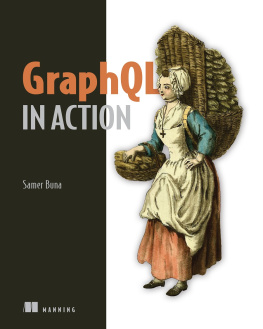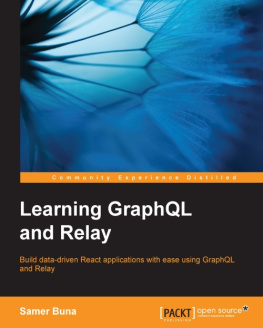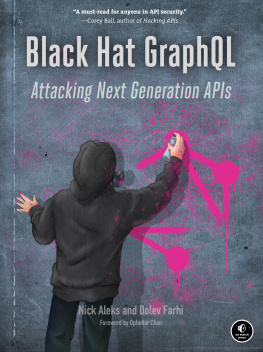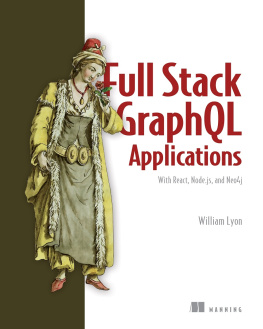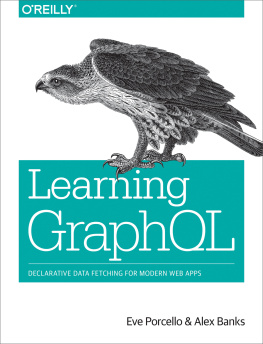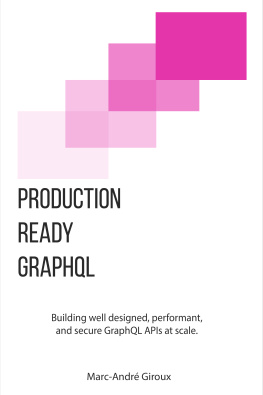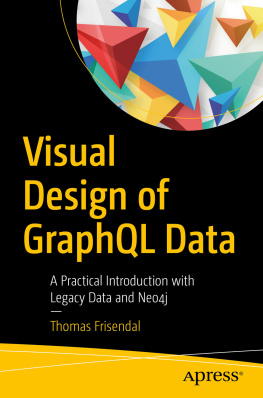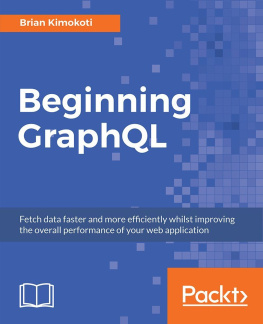
GraphQL in Action
Samer Buna
To comment go to liveBook

Manning
Shelter Island
For more information on this and other Manning titles go to
manning.com
inside front cover
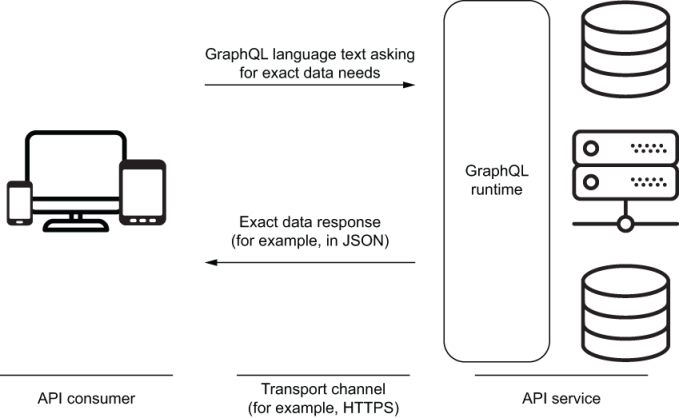
Copyright
For online information and ordering of these and other Manning books, please visit manning.com. The publisher offers discounts on these books when ordered in quantity.
For more information, please contact
Special Sales Department
Manning Publications Co.
20 Baldwin Road
PO Box 761
Shelter Island, NY 11964
Email: orders@manning.com
2021 by Manning Publications Co. All rights reserved.
No part of this publication may be reproduced, stored in a retrieval system, or transmitted, in any form or by means electronic, mechanical, photocopying, or otherwise, without prior written permission of the publisher.
Many of the designations used by manufacturers and sellers to distinguish their products are claimed as trademarks. Where those designations appear in the book, and Manning Publications was aware of a trademark claim, the designations have been printed in initial caps or all caps.
Recognizing the importance of preserving what has been written, it is Mannings policy to have the books we publish printed on acid-free paper, and we exert our best efforts to that end. Recognizing also our responsibility to conserve the resources of our planet, Manning books are printed on paper that is at least 15 percent recycled and processed without the use of elemental chlorine.

| Manning Publications Co. 20 Baldwin Road Technical PO Box 761 Shelter Island, NY 11964 |
Development editor: | Karen Miller |
Technical development editor: | Alain Couniot |
Review editor: | Aleksandar Dragosavljevi |
Production editor: | Deirdre Hiam |
Copy editor: | Tiffany Taylor |
Proofreader: | Katie Tennant |
Technical proofreader: | Valentin Crettaz |
Typesetter: | Gordan Salinovi |
Cover designer: | Marija Tudor |
ISBN: 9781617295683
dedication
To my wife, Chalena,
for all your unconditional, loving support.
To my children, Odin, Ally, and Leo,
for inspiring me each and every day.
To my parents, Nemeh and Sharif,
for teaching me the value of hard work and always pushing me to the limit.
front matter
preface
GraphQL is a game changer. It immediately grabbed my full attention when I first heard about it back in 2015, when Facebook first announced the project. Ive been a frustrated maintainer and user of multiple REST-ish APIs, and hearing how Facebook engineers were trying to solve common data API problems with this new GraphQL language was a clear sign for me to learn about it.
GraphQL has many advantages and disadvantages. It solves many technical problems beautifully; but the best thing about it, in my opinion, is that it greatly improves the communication process between frontend clients and backend services. Not only does GraphQL make communication a lot more efficient for both sides, but it also gives them both a rich, declarative language. GraphQL services can use that language to express what data they can provide, and GraphQL clients can use the language to express what data they need. GraphQL also enables frontend developers to be independent of backend developers, and that in itself is a big deal. Frontend developers get more freedom and a stronger impact on the features of the data APIs they use.
GraphQL is programming-language agnostic. You can create GraphQL services in JavaScript, Java, Ruby, Python, C#, PHP, Go, and many other languages. However, I had to pick a programming language for the project were building in this book. I chose JavaScript because it is the most popular programming language out there. This does mean you need to be familiar with JavaScript to get the best value out of this book, including modern JavaScript (ECMAScript 2015+) and the Node.js runtime. The books project also uses the React JavaScript library in chapters 9 and 10, but all the React code is provided and explained where needed.
There is no shortage of learning resources for GraphQL, but what I noticed while learning it is a scarcity of practical, non-abstract materials. That is why I designed this book to be a practical reference for working with a full-stack GraphQL-based project.
This book took me a long time to produce. I researched and developed the ideal flow for learning the many concepts covered in the book. I also provide many resources to make your learning experience as smooth as possible. The book features a GitHub repository, and progress milestones throughout the book have Git branches that you can check out. I hope this will help you better follow the code and allow you to restart at any point.
Learning GraphQL was one of the best time investments I have ever made. GraphQL allows me to implement ideas faster, and it makes my projects perform better. Working with GraphQL is simply a more pleasant experience overall. I hope this book will enable you to make that investment and join in on all the joy we GraphQL lovers are having in the GraphQL ecosystem of excellence.
acknowledgments
This book would not have been possible without the excellent contributions of many people. Im privileged to have those people in my life, and I profoundly appreciate them for helping me produce the best possible version of this book.
Huge thanks go to the Manning team for their patience and guidance throughout the writing of this book. Special thanks go to Karen Miller, my developmental editor, and Tiffany Taylor, my copyeditor, who both taught me a great deal about efficient and clear writing. I would also like to thank Deirdre Hiam, my project editor; Katie Tennant, my proofreader; and Aleksandar Dragosavljevic, my reviewing editor. Im grateful for all their tireless work to improve the language and presentations of the book. Writing for Manning was one of the best book-writing experiences I have ever had.
Many awesome software developers read drafts of this book and gave me valuable feedback about how to improve things. I am grateful for all of you, especially my technical reviewer, Valentin Crettaz, who found problems in the draft that I would have never found with my biased eyes. Id like to also thank my friends Kyle Holden and Raymond Ly, and my wife, Chalena, for proofreading the language of the book and helping me fine-tune the grammar and phrasing to better communicate my thoughts.
Id like to also thank my mentors in the GraphQL ecosystem, from whom I learned a lot. They inspired me, encouraged me, and kept me in check throughout the process of getting this book out. Special thanks go to Lee Byron for answering many of my questions and making sure the topics and flow of this book are as useful as they can be.
Next page
